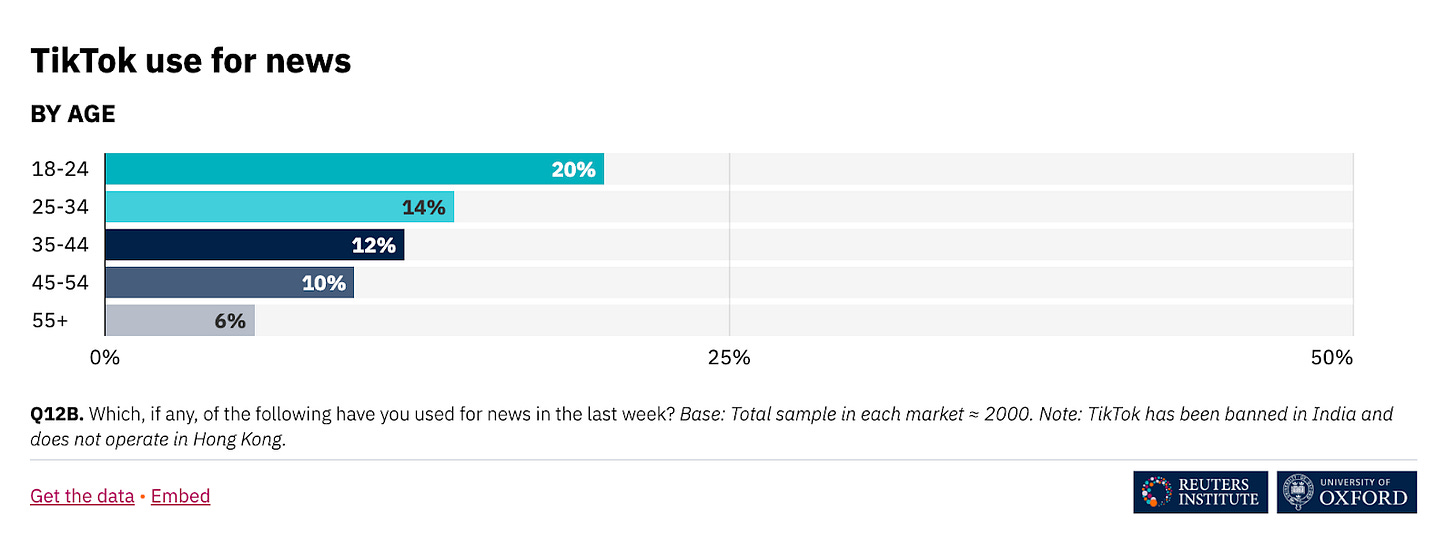Press Forward, rise in nonprofits highlight 2023 trends
Our annual look at hopeful trends shows more philanthropic interest in local news, rise of news startups

The holiday season is a time to look back on an eventful year in our industry and to consider what will come in the year ahead. In this newsletter, we round up the top trends of 2023, and we’ll be back in January with a look ahead to Knight’s priorities for 2024.
We know that it’s been a challenging year for many local journalists, especially those at publications that have suffered a shutdown or job losses. But there are also some incredibly hopeful signs, including the ambitious coalition of funders in Press Forward and the rise of so many new and converted nonprofit newsrooms. Even the folks at Northwestern’s Local News Initiative included a map of bright spots for local news around the country. That’s the proverbial cherry on top of the Christmas tree.
So, here’s a roundup of trends in journalism that give us cheer as the calendar turns to 2024.
💸 1. Press Forward captures our imagination. Yes, it’s a big tanker ship floating around in the middle of the ocean with $500 million and no captain yet, but still, it’s $500 million committed by 22 funders (including Knight) for local news in America over five years! The details are energizing and inspiring: Strengthening trusted local newsrooms; scaling up the infrastructure of local journalism; closing long-standing inequities in coverage and practice; and advancing relevant public policies. Plus, the first slate of Press Forward local chapters were announced, as well as MacArthur Foundation’s initial $48 million set of grants to the pooled fund and aligned funding to newsrooms and national support organizations. To say that these are exciting times for rethinking and reimagining local news is the understatement of the year.
🚀 2. Nonprofit startups, nonprofit conversions, nonprofit rebirths. If it weren’t edged out by Press Forward, this would certainly be the Year of the Nonprofit Newsroom. The American Journalism Project’s fingerprints are all over this trend, as they helped shepherd the launch of two big nonprofit startups, Mirror Indy and Signal Akron, on December 5, with both focusing on listening to and working with their communities. And then there’s the growing trend of for-profit newsrooms converting to nonprofits, including the Long Beach Post and nearly every major newspaper in Maine (the latter thanks to the National Trust for Local News). Considering a conversion yourself? The Institute for Nonprofit News (INN) has a guide for that. And there’s no lack of creativity, with a Lancaster County (Pa.) newspaper owner gifting the paper to the local public media station, and the Kent (Conn.) Good Times Dispatch coming back to life as a nonprofit after being defunct for 14 years. Let the good times roll.
🤖 3. Damn the robot torpedoes! Let’s make a deal with OpenAI. You’ve likely heard that artificial intelligence (AI) could lead to human extinction. Or the loss of many jobs, including in journalism. Or that CNET got into hot water for using generative AI for stories without disclosure. Or that ChatGPT’s owner, OpenAI, lost its CEO for a few days over worries of said extinction. It’s been a weird and wooly year for OpenAI—and AI in general—but that hasn’t stopped journalism outlets from making deals with the organization. First up, the Associated Press announced a partnership with OpenAI to allow the firm to license AP’s text content, while giving the AP access to OpenAI’s technology and tools. Next, the AJP announced $5 million in funding and $5 million in tech credits from OpenAI to launch a new AI studio and give grants to 10 AJP-funded newsrooms to experiment with the technology. And in case anything could go wrong (imagine that), OpenAI funded an ethics initiative at New York University’s journalism school. “As trust in the media declines, and advances in technology pose fresh challenges, practicing journalism ethically is more important than it’s ever been,” the initiative’s leader Stephen Adler said.
♪ 4. Tiktok offers news with a beat. We’ve grappled with people getting news on Twitter, and then Facebook, and then Instagram, and now TikTok. The Chinese-owned app has certainly captured the attention of lip-synching fans around the globe, who are now getting news there more than ever. The global Digital News Report found that 20 percent of 18- to 24-year-olds went to TikTok for news, while a recent Pew Research Center report found that 43 percent of American TikTok users regularly go there for news. While many TikTok users trust “personalities” for news on the platform, news publishers are starting to ramp up content there, too. That’s led TikTok to offer a new product, Pulse Premiere, that will allow top creators, including BuzzFeed, Conde Nast and NBC, to get a 50 percent cut of ads sold next to their content. While publishers have had some success on other platforms, “this partnership with TikTok is really just taking off,” Pam Drucker Mann, global chief revenue officer at Conde Nast, told the Wall Street Journal. “The potential there is pretty significant.”
📈 5. News startups proliferate around the country. It’s exciting to see blockbuster nonprofit startups in metro areas around the country, with millions in funding. But even more exciting are the efforts to plug the information gaps in news deserts in rural and urban neighborhoods, especially in communities of color. The AJP announced its first incubator grantees, helping to serve people of color in Boston and the LGBTQAI+ community in Phoenix. The Tiny News Collective (TNC) has helped launch 25 startups over the past two years, mostly by founders of color. TNC received a $2 million grant from Knight Foundation and recently hired its first executive director, Amy Kovac-Ashley. TNC is now working with two new incubators funded through Wichita Foundation and the New Mexico Local News Fund, meaning that more founders can get access to TNC’s support and tools with the help of local funding. It’s a promising model for news entrepreneurship.
👏🏾 6. Diversity gains in newsrooms, leadership, but more needed. It was the year of “yes, but…” when it comes to gains in diversity, equity and inclusion in journalism. On the plus side, the Online News Association (LaSharah Bunting), Institute for Nonprofit News (Karen Rundlet) and Knight Foundation (Maribel Perez Wadsworth) all hired women of color as their leaders. But, while the INN DEI Index report showed that more nonprofit newsroom staff reflected the racial and ethnic composition of America, “the degree of diversity is stronger at the staff level than at the leadership level,” the report said. A Digiday study found that more newsrooms are less white- and male-dominated, but an internal audit at the New York Times found that Black and Latino staffers were less likely to get strong job ratings than their white peers. And the Washington Post Guild study found that women of color made less money than their white and male peers. “Retaining employees from diverse backgrounds is a challenge publishers continue to face, especially when there are systemic issues at hand,” the Digiday report concluded.
🏛️ 7. Policy wins for local news led by the states. In America, states are often considered the laboratories for democracy at the federal level. That’s also true when it comes to public policy supporting local news. While there’s been a bipartisan bill introduced in the U.S. Congress, the Community News and Small Business Support Act, there’s been a lot more action—and passage—at the state level. All this has been ably tracked and organized by Rebuild Local News, a recipient of funding from the recent MacArthur grants. New Jersey has been leading the way through its state-funded New Jersey Civic Information Consortium, which received another $4 million to re-grant from the State Legislature. Plus, local news fellowship programs have received millions of dollars in support from legislatures in New Mexico, California and Washington state. Cities haven’t been left out, with New York City appropriating a portion of its marketing budget to community news outlets, and Chicago and San Francisco were inspired to follow suit.
Quote of the Year
“Racial and ethnic diversity, equity and belonging must be among the pillars of [Press Forward’s] foundation. An equitable distribution of resources and opportunities ensures that underrepresented voices are heard and elevated by journalists, leaders and publishers who know them best.”
— An open letter to Press Forward from a number of support organizations for people of color
News @ Knight Credits
Written by Jim Brady, with Mark Glaser
Edited by Jim Brady, Jessica Clark and Kara Pickman







